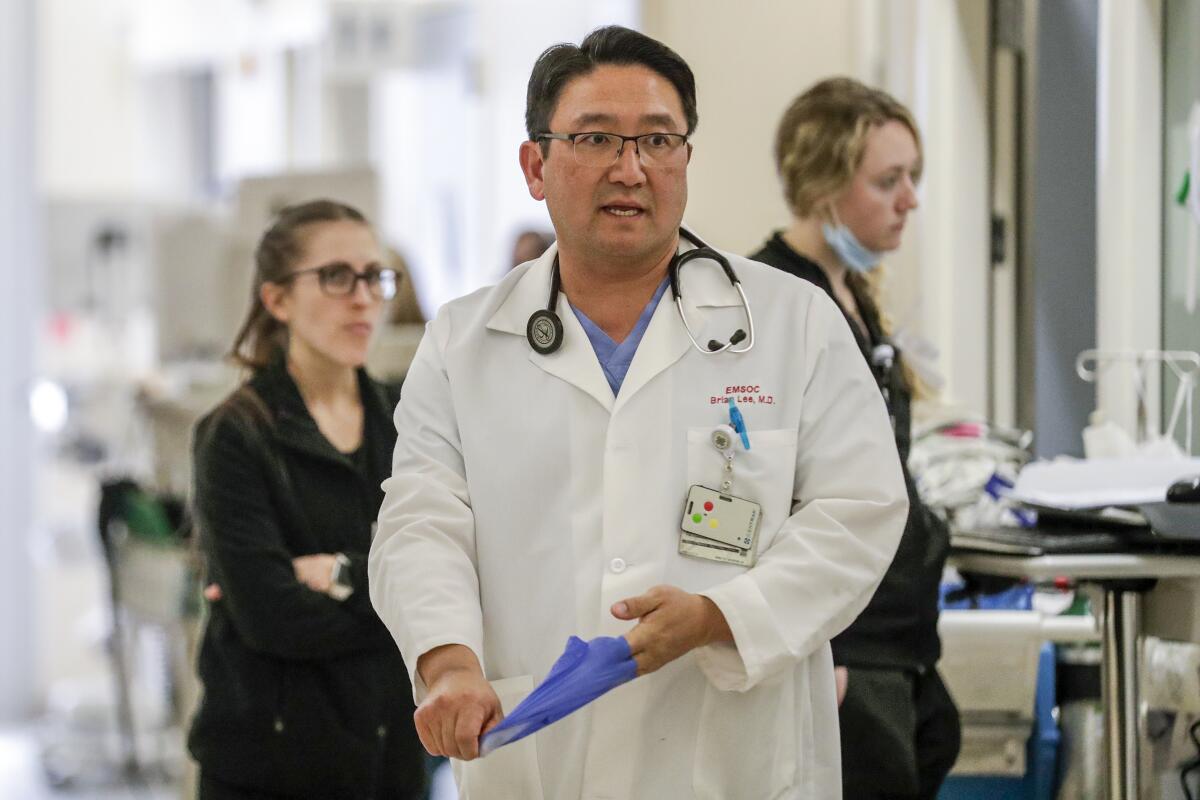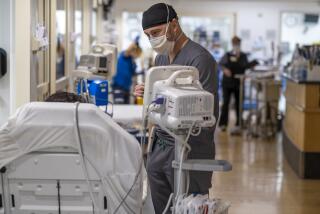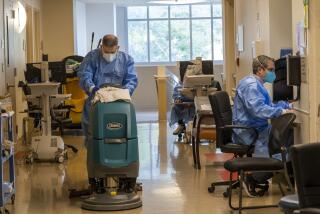Anxiety mounts among U.S. health workers on the front lines of coronavirus outbreak

Doctors and nurses say they are alarmed by reports that multiple health workers in the United States have been sickened by a deadly coronavirus and that hospitals and other healthcare facilities appear to have become hot spots for the spread of infections.
On Sunday, health officials announced that two staff members at a Northern California hospital had contracted COVID-19 from a patient. A day earlier, officials said that a health worker at a Seattle nursing home had been hospitalized with the disease and that several more staff members would probably test positive in the coming days.
Medical workers on the front lines of an epidemic often make up a disproportionate number of cases because of their close contact with sick patients and repeated exposure to a virus. Some hospital staffers say they fear delays in testing for COVID-19 in the U.S. have exposed them to the virus already.
In the United States, the conversations taking place in hospital hallways and clinic break rooms are heightened by the specter of China’s death toll, which includes several medical workers who have died not only of COVID-19 infection but of ailments caused by overwork and fatigue.
One of the most publicized deaths from the global outbreak has been that of Dr. Li Wenliang, a 34-year-old physician who sounded the alarm about sick patients in Wuhan, China, the outbreak’s epicenter.
There are more than 80 reported cases in the United States. Sunday night, officials in Washington state announced that a second person infected with the virus had died: a man in his 70s who lived at a nursing home. They also reported four new cases, bringing the total in King County to 10.
With the coronavirus expected to spread within the United States, doctors and nurses say they are nervously watching as stockpiles of masks and other protective gear in hospitals dwindle amid an equipment shortage. The flu season has further complicated efforts to identify suspected COVID-19 cases because the two infections have similar symptoms.
Physicians say it has become increasingly challenging to monitor the shifting recommendations for treating and testing for COVID-19 while also trying to care for anxious patients and prevent exposure to the virus among themselves and their colleagues.
“I have to go back home and I have to worry about my family and what I could be carrying back to them,” said Dr. Suman Radhakrishna, an infectious disease specialist at Hollywood Presbyterian Medical Center in Los Angeles. “There are no martyrs here.”
The novel coronavirus originated in China late last year and has since infected more than 89,000 people in dozens of countries. The first evidence that the virus was circulating in the United States came last week when a patient at UC Davis Medical Center in Sacramento was diagnosed with the virus and hadn’t traveled to an affected country or had close contact with anyone who did.
That patient has exposed dozens, if not hundreds, of health workers to COVID-19 and provides a glimpse into the consequences of insufficient safety measures. The patient was not treated with the recommended COVID-19 precautions because for several days the Centers for Disease Control and Prevention would not allow her to be tested.
At UC Davis Medical Center, 124 nurses and other staff members have been asked to stay home because of possible exposure to the patient, according to the state nurses union.
Before being transferred to UC Davis, the patient had been admitted to NorthBay VacaValley Hospital in Vacaville. On Sunday, officials announced that two workers at the Solano County facility had COVID-19.
“This underscores the challenging environment that health care workers everywhere face to stem the spread of communicable diseases, including COVID-19,” Dr. Bela Matyas, health officer for Solano County, said in a statement.
One of the infected healthcare workers is a Solano County resident and the other lives in Alameda County, officials said. The case is the first for Alameda County, which has declared a local public health emergency in response.
For most people, COVID-19 causes a mild sickness, and some who are infected do not even know they are ill. The virus has been estimated to kill two of every 100 people who contract it, though the risk is lower for younger people and higher for the elderly, experts said.
But medical professionals can be in more danger than others. Being exposed to multiple people who are very sick — the way someone working in a hospital would be — typically makes someone sicker than if they were exposed to only one person who was mildly ill.
Plus, hospital procedures, such as intubating a patient, may release large amounts of the virus that can easily infect workers in the room. When SARS, another coronavirus, was spreading around the world in 2003, a single patient at a hospital in Hong Kong is believed to have infected 138 people with the disease.
It is unclear whether this coronavirus will be that transmissible in a hospital setting. One small study of COVID-19 patients hospitalized with pneumonia in Wuhan found that 41% of cases appeared to be hospital-acquired. A much larger analysis, evaluating 45,000 COVID-19 patients in mainland China, found that 3.8% were healthcare workers.
In outbreaks in other countries, the virus has shown rapid spread in high-density settings, including hospitals, said Lawrence Gostin, the director of the World Health Organization Collaborating Center on National and Global Health Law. If the virus sweeps the U.S. the way it has other countries, healthcare facilities could be filled with COVID-19 patients, he said.
“Not only will we see many deaths, but we’ll see anywhere from 5% to 20% of people infected needing hospitalization,” Gostin said. “How will America cope with that?”
At Hollywood Presbyterian hospital, panic among the staff began to escalate last week as federal officials began discussing the possibility of closing schools and said the virus was expected to spread within U.S. communities, Radhakrishna said.
When a patient showed up at the hospital with a cough, staffers initially jumped to a false conclusion that the patient may have COVID-19, she said. The news spread swiftly across the hospital.
“All of a sudden, in a matter of minutes, it became a big thing,” she said. “It brings back memories of when we didn’t know what HIV was up to and everyone was so afraid.”
The fear is stoked by the constant stream of new and sometimes conflicting information about the virus. Officials regularly change protocols around testing and treatment as they learn more.
“I’ve never heard the words ‘rapidly evolving’ more times than I have in the past three weeks,” said Adam Blackstone, spokesman for the Hospital Assn. of Southern California.
Though the number of cases in the country remains relatively low, increasing concerns involving healthcare and other front-line workers have surfaced in recent days.
On Thursday, a whistleblower complaint alleged that federal health workers were not provided adequate training and protective gear when dealing with quarantined people at two California military bases. The whistleblower has also alleged retaliation by superiors for speaking up.
In a Seattle suburb, a nursing home called Life Care Center has become a focal point of the virus scare.
There, more than 50 residents and staffers have symptoms, officials said. Twenty-five firefighters who visited the nursing home while people were ill have also been asked to self-quarantine, according to the International Assn. of Fire Fighters.
On Sunday night, Washington officials announced that the state’s second person to die of the COVID-19 virus was a resident of Life Care. He was in his 70s and had underlying health conditions. The first man who died was in his 50s and had no apparent connection to the nursing home.
Some healthcare workers are questioning the recommended precautions as cases mount nationwide. The CDC advises that all healthcare personnel who interact with infected patients wear gowns, gloves, goggles and masks. But UC San Francisco nurse Maureen Dugan worries that level of protection is not sufficient given how little is known about this new virus.
“That leaves parts of our face potentially and our neck and feet available for exposure,” she said. “We believe in the precautionary principle … you use the highest level of personal protective equipment.”
Similarly, UC Davis nurse Melissa Johnson-Camacho, the chief nurse representative for the California Nurses Assn., said she is pushing for the hospital to adopt a protocol developed for the Ebola virus to use for COVID-19 patients. She said relying on CDC recommendations isn’t enough.
“There’s definitely alarm there in that area,” she said.
At many hospitals, the flu season has muddled the COVID-19 picture. The two diseases have identical symptoms, including cough and fever, so physicians can’t rely on how a patient is feeling to determine the cause.
USC infectious disease specialist Dr. Neha Nanda said physicians still consider a patient’s travel history when deciding whether a COVID-19 test is needed. So far, there has been only one confirmed case of COVID-19 in L.A. County.
Without a history of travel to China, Italy or another country with a large outbreak, doctors assume the patient probably has the flu, she said.
“The prevalence of influenza is way higher than COVID-19 in our community,” Nanda said. “But it’s not as foolproof as it was two weeks back.”
Times staff writers Alex Wigglesworth in Los Angeles and Richard Read in Seattle contributed to this report.
More to Read
Sign up for Essential California
The most important California stories and recommendations in your inbox every morning.
You may occasionally receive promotional content from the Los Angeles Times.











